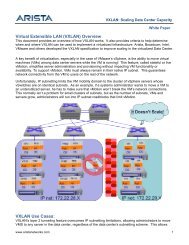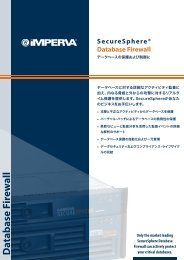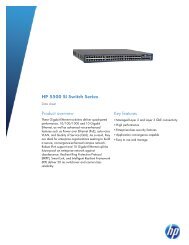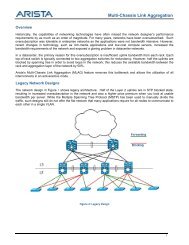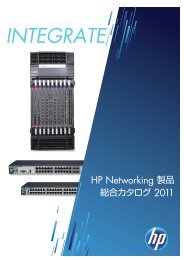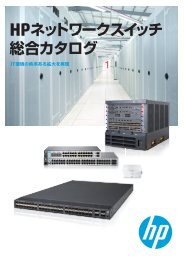HP 5120 SI Switch Series data sheet - US English
HP 5120 SI Switch Series data sheet - US English
HP 5120 SI Switch Series data sheet - US English
Create successful ePaper yourself
Turn your PDF publications into a flip-book with our unique Google optimized e-Paper software.
Features and benefits<br />
Quality of Service (QoS)<br />
• Broadcast control: allows limitation of broadcast<br />
traffic rate to cut down on unwanted network<br />
broadcast traffic<br />
• Powerful QoS feature: supports the following<br />
congestion actions: strict priority (SP) queuing,<br />
SDWRR, and SP+SDWRR<br />
• Advanced classifier-based QoS: classifies<br />
traffic using multiple match criteria based on Layer<br />
2, 3, and 4 information; applies QoS policies such<br />
as setting priority level and rate limit to selected<br />
traffic on a per-port basis<br />
Management<br />
• Friendly port names: allow assignment of<br />
descriptive names to ports<br />
• Remote configuration and management: is<br />
available through a secure Web browser or a<br />
command-line interface (CLI)<br />
• Manager and operator privilege levels:<br />
enable read-only (operator) and read/write<br />
(manager) access on CLI and Web browser<br />
management interfaces<br />
• Command authorization: leverages RADI<strong>US</strong> to<br />
link a custom list of CLI commands to an individual<br />
network administrator's login; also provides an audit<br />
trail<br />
• Secure Web GUI: provides a secure, easy-to-use<br />
graphical interface for configuring the module via<br />
HTTPS<br />
• Dual flash images: provide independent primary<br />
and secondary operating system files for backup<br />
while upgrading<br />
• Multiple configuration files: can be stored to<br />
the flash image<br />
• Complete session logging: provides detailed<br />
information for problem identification and resolution<br />
• SNMPv1, v2c, and v3: facilitate centralized<br />
discovery, monitoring, and secure management of<br />
networking devices<br />
• Remote monitoring (RMON): uses standard<br />
SNMP to monitor essential network functions;<br />
supports events, alarm, history, and statistics group<br />
plus a private alarm extension group<br />
• IEEE 802.1AB Link Layer Discovery Protocol<br />
(LLDP): automated device discovery protocol<br />
provides easy mapping by network management<br />
applications<br />
• Management VLAN: segments traffic to and<br />
from management interfaces, including CLI/telnet, a<br />
Web browser interface, and SNMP<br />
• Device Link Detection Protocol (DLDP):<br />
monitors a cable between two switches and shuts<br />
down the ports on both ends if the cable is broken,<br />
this prevents network problems such as loops<br />
Connectivity<br />
• Auto-MDIX: automatically adjusts for<br />
straight-through or crossover cables on all<br />
10/100/1000 ports<br />
• Flow control: using standard IEEE 802.3x, it<br />
provides back pressure to reduce congestion in<br />
heavy traffic situations<br />
• Jumbo packet support: supports up to 10k byte<br />
frame size to improve performance of large <strong>data</strong><br />
transfers<br />
• High-density port connectivity: provides up to<br />
48 fixed 10/100/1000BASE-T ports in an<br />
entry-level static Layer 3 switch<br />
• Ethernet OAM: provides a Layer 2 link<br />
performance and fault detection monitoring tool,<br />
which reduces failover and network convergence<br />
times<br />
• Power over Ethernet Plus (PoE+) support:<br />
provides 30 W power for connected devices,<br />
simplifies deployment, and dramatically reduces<br />
installation costs by helping to eliminate the time<br />
and cost involved in supplying local power at each<br />
access point location<br />
• IPv6:<br />
– IPv6 Host: enables switches to be managed and<br />
deployed at the IPv6 network's edge<br />
– Dual stack (IPv4 and IPv6 using BIS):<br />
allows IPv4 hosts to communicate with IPv6 hosts<br />
– IPv6 ACL: for filtering IPv6 network traffic<br />
Performance<br />
• Nonblocking architecture: up to 104 Gbps<br />
nonblocking switching fabric provides wire-speed<br />
switching with up to 77.4 million pps throughput<br />
• Hardware-based wire-speed access control<br />
lists (ACLs): feature-rich ACL implementation<br />
(TCAM-based) helps ensure high levels of security<br />
and ease of administration without impacting<br />
network performance<br />
2




